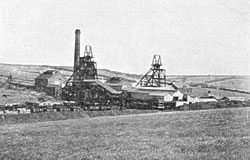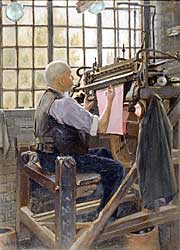
 |
Gedling colliery, c1910. |
Subject overview
Nottinghamshire has passed through various phases in terms of industry and manufacturing. In the medieval period manufacturing was associated with craft work, and the production of wool. Nottingham benefited from a grant by King John in 1199 of a merchants' gild with the exclusive privilege of manufacturing dyed cloth or cloth designed to receive a dye within 10 miles of the town.
Coal was mined in the Nottingham area as early as the thirteenth century, pottery was made at various locations in the county, and alabaster and leather work were other significant products made in the county.
Knitting and coal mining expanded in the sixteenth century. Hand knitting was established in Nottingham by 1519 using local wools; William Lee of Calverton invented the stocking knitting frame in the 1580s, and by 1641 Nottingham already had two master-stockingers. By the end of the seventeenth century Nottingham had become the centre of worsted stocking knitting, and the trade was to flourish in the town and surrounding villages during the eighteenth century.
Coal mining in the sixteenth century was associated with the Willoughbys at Wollaton, where sales helped to fund the building of their country house. Other pits were worked in the same area, by different families.
By the end of the eighteenth century Robert Lowe, writing of Nottinghamshire, noted hosiery manufacture, cotton mills, and the beginnings of lace making. Lace, once it transferred to machine production, became the most substantial textile interest of the nineteenth century in Nottingham and many of its surrounding villages.
 |
The Stockinger by Walter Farmer (image courtesy of Nottingham City Museums.) |
Hosiery and cotton remained important in Mansfield, at least until towards the end of the nineteenth century when, with the opening up of deep mining in the Erewash Valley, it was transformed (together with Kirkby-in-Ashfield and Sutton-in-Ashfield) into a major mining area. The impact of coal working in this area and around Eastwood is vividly portrayed in some of the novels of D.H. Lawrence.
The 20th century saw considerable changes in industry. During the inter-war years the opening up of new deep mines, and the building of colliery villages in their vicinity, spread coal mining to various areas of the county, but the subsequent loss of the industry in the Erewash Valley, and the erosion of confidence in coal following the miners' strikes of the 1970s and 1980s, led to its eventual disappearance, leaving significant difficulties in the mining communities.
Nottingham lace went into decline with changing fashions after the First World War, although hosiery production help up well until undermined by competition from the Pacific Rim in the 1980s and 1990s.
With coal and textiles in decline, the city of Nottingham benefited from the development of new industries. However, bicycle production and cigarette manufacture, both major inter-war industries, are today in serious decline. No bicycles are now made in Nottingham.
The other new industry of the late nineteenth and early twentieth century, pharmaceuticals has flourished, but Nottingham today is best represented by its commercial and service interests, notably fast growing credit companies such as Experian and Capital One, and hi-tech industries.
Regeneration has been necessary, but has proved more difficult in some of the small towns, notably the Mansfield conurbation and Newark. Service work is now the most substantial employer in the county.